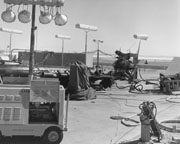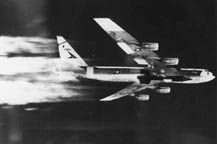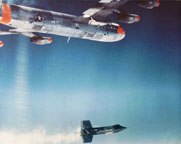

In May and June 1960, NASA was expanding the flight envelope of the X-15-1. Scott Crossfield was concluding the contractor demonstration of the X-15-2 with its pair of XLR-11 engines.
On three occasions, preparations were made to launch Joe Walker in the X-15-1 to make an assault on Mel Apt's speed record, mach 3.196 (2094 miles per hour), set in the X-2 on September 27, 1956. Launch attempts were aborted on May 27 and June 3. The third launch attempt was scheduled for June 8.
In the meantime, the X-15-3 had arrived at Edwards with its XLR-99 rocket engine, and ground tests of the big engine were initiated. For these tests, the X-15-3 was locked in a ground test frame. While the test team sought refuge in a concrete block house, Scott Crossfield would enter the cockpit of the X-15 to operate the rocket engine.
The XLR-99 produced four times the thrust of the XLR-11 twin packs that equipped the first two X-15s when they were delivered. These were the first rocket engines that could be controlled with a throttle, providing any desired level of thrust from 20,000 pounds to 60,000 pounds. The new engines burned a different fuel than the XLR-11 engines had used. The water alcohol fuel mixture of the XLR-11s was similar to martini. The XLR-99 burned extremely noxious anhydrous ammonia. It was much more hazardous to handle, but packed more energy into the same volume of fuel.
The second ground test of the XLR-99 was conducted on June 8. During the test, a regulator valve on the ammonia tank failed in the open position. The ground crew had placed the end of the hose leading from the ammonia tank pressure relief valve in a tank of water to absorb the ammonia fumes. The backpressure in the hose prevented the relief valve from properly venting the pressure in the tank. A faulty pressure gauge in the cockpit failed to reveal the overpressure in the ammonia tank to Crossfield. Eventually, the pressure in the ammonia tank exceeded the strength of the tank, and it failed. Parts of it struck the adjacent hydrogen peroxide tank, which detonated. That caused the ammonia tank contents to ignite and a major explosion shattered the tail of the X-15, scattering bits of Inconel-X in all directions. The remaining fuselage was hurled forward about twenty feet. Protected by the heat resistant cockpit of the X-15, Crossfield was not injured in the explosion and fire.
 X-15-3 after explosion of XLR-99 engine on June
8, 1960. Photo courtesy AFFTC/HO.
X-15-3 after explosion of XLR-99 engine on June
8, 1960. Photo courtesy AFFTC/HO.
The June 8 attempt to launch the X-15-1 was immediately cancelled following the explosion of the X-15-3. The entire X-15 program had to be restructured. The X-15-3 would not fly for another 18 months. The X-15-2 took the place of the X-15-3 as the primary vahicle for the first flight tests of the XLR-99. It was shipped to El Segundo to be torn down and have its new engine installed. For the time being, the X-15-1 was the only vehicle available to the program. No X-15 flights were attempted for nearly two months.
On August 4, 1960 Major Jack Allavie and Major Fitzhugh Fulton launched Joe Walker from the NB-52A over Silver Lake on mission 1-9-17. Walker lit all eight chambers of the X-15-1 and pulled up to fly at the angle of attack calculated to produce the highest value of lift over drag. At 74,000 feet altitude, he pushed over to fly a parabolic arc. Flying at zero-g he accelerated to mach 3.31 (2,195 miles per hour). Joe Walker exceeded Mel Apt's speed of 2,094 miles per hour by a hundred miles per hour.
 The X-15-1 drops away from the
NB-52A in August 1960. A dayglo orange band has been added to the
rear fuselage. This is the maximum amount of Day-Glo worn by the
NB-52A. Photo courtesy AFFTC/HO.
The X-15-1 drops away from the
NB-52A in August 1960. A dayglo orange band has been added to the
rear fuselage. This is the maximum amount of Day-Glo worn by the
NB-52A. Photo courtesy AFFTC/HO.
While Walker pushed the top speed of the X-15, Major Bob White was assigned to fly the high altitude flights. His first altitude record attempt was aborted before launch on August 11, 1960. The next day Major Fulton and Major Allavie launched Major White from the NB-52A over Silver Lake. He flew the maximum lift over drag profile to an altitude of 60,000 feet. He leveled off and accelerated to mach 1.9. He then pulled up at 1.5 g's until he had pulled the stick all the way to its limit of travel. The engine burned out at an altitude of 120,000 feet and the X-15 coasted on up to 136,500 feet. This was the first flight to exceed Ivan Kinchloe's record, 125,907 feet attained in the X-2 on September 7, 1956. The top speed attained by the X-15-1 on the flight was mach 2.52 (1,772 miles per hour).
 NB-52A launches the X-15-1 on what may be Bob
White's flight to 131,000 feet altitude on August 12, 1960. Photo
courtesy AFFTC/HO.
NB-52A launches the X-15-1 on what may be Bob
White's flight to 131,000 feet altitude on August 12, 1960. Photo
courtesy AFFTC/HO.
*The first position of the mission number identifies which X-15 was involved, the second number indicates how many times that X-15 had been launched, and the third number indicates how many times it had been carried by an NB-52.
Send a message to Brian
Go to home page of the Goleta Air & Space Museum.
Edited July 12, 2000.